King Tiglath Pileser's biblical presence shapes ancient narratives, teasing the convergence of history and divine intervention.
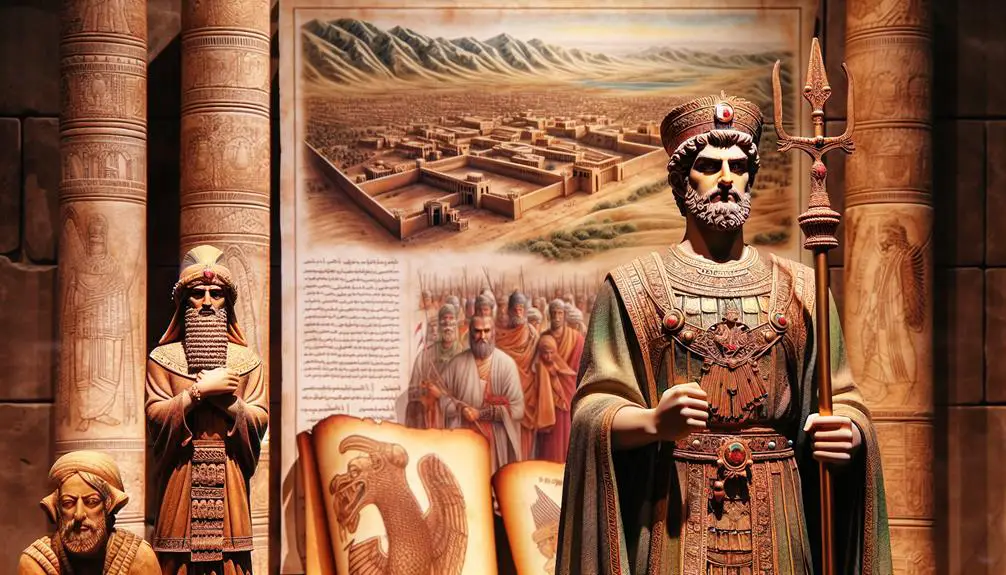
Tiglath Pileser in the Bible
Nearly 60 references to Tiglath Pileser appear across the Old Testament, marking him as a significant figure in biblical history. You'll find his military campaigns and interactions with Israel and Judah particularly fascinating, as they not only shaped the geopolitical landscape of the ancient Near East but also had profound theological implications.
As you explore the life and legacy of this Assyrian king, you'll uncover how his reign influenced the course of biblical events and the complex relationship between historical facts and spiritual truths.
The question remains: how did his actions align with the divine narrative woven through the scriptures? This intriguing intersection of history and faith awaits your further exploration.
Key Takeaways
- Tiglath Pileser III's military campaigns significantly impacted the geopolitics of Israel and Judah.
- His reign is depicted as an instrument of divine judgment in the biblical narrative.
- The Assyrian king's dominance prompted theological reflections and evolution among the Israelites and Judeans.
- Prophetic messages in the Bible were influenced by the geopolitical and theological challenges posed by Tiglath Pileser's rule.
Historical Background
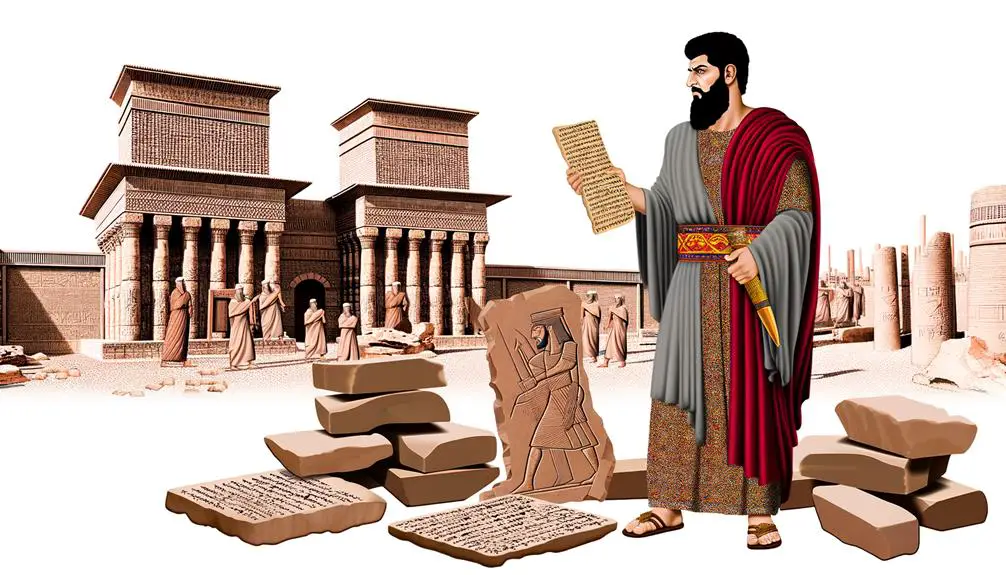
Tiglath Pileser III, a king who reshaped the political landscape of the Near East, ascended the Assyrian throne in 745 BCE, ushering in a period of unprecedented expansion and reform. His reign marked a pivotal point in the history of the Assyrian Empire, characterized by aggressive military campaigns and a strategic approach to governance that facilitated the empire's rapid growth. His efforts not only expanded the empire's borders but also solidified its dominance over rival states.
Central to understanding Tiglath Pileser III's approach to empire-building are the royal inscriptions. These texts, carved in stone or inscribed on clay tablets, serve as a primary source for historians studying Assyrian expansion under his rule. They detail his military conquests, administrative reforms, and the integration of conquered peoples into the Assyrian state. Through these inscriptions, Tiglath Pileser III communicated his achievements to his subjects and future generations, projecting an image of divine sanction and invincibility.
The inscriptions reveal a ruler adept at leveraging military success to secure political power. His campaigns extended Assyrian control over vast territories, including parts of modern-day Iran, Syria, and Israel. This expansion wasn't merely territorial; it was a strategic appropriation of resources and labor that bolstered the Assyrian economy and reinforced its military capabilities.
Biblical References
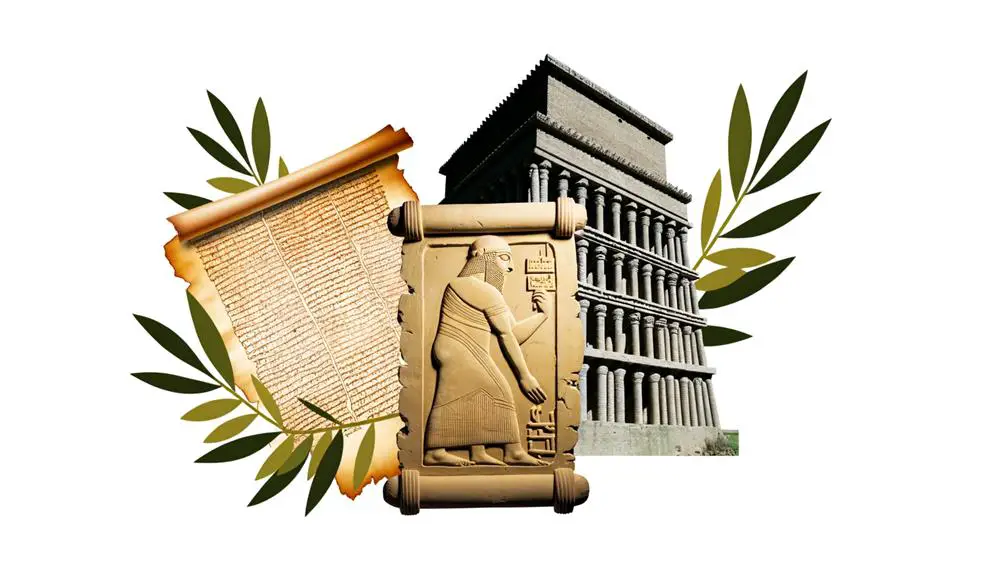
In the scriptures, one encounters references to Tiglath Pileser III, revealing his significant impact on the regions and peoples mentioned in the Bible. His involvement isn't merely historical but also deeply intertwined with the prophetic literature, indicating his role as a pivotal figure in the unfolding biblical narrative.
Analyzing the biblical references, you'll find:
- The name origin of Tiglath Pileser is rooted in the Akkadian language, signifying 'my trust is in the son of Esharra,' which underscores the Assyrian king's divine association and the cultural context of his reign.
- Prophetic mentions of Tiglath Pileser in the Bible underscore his role as an instrument of divine judgment. These narratives don't only recount historical events but also interpret them through a theological lens, suggesting that his military campaigns and interactions with Israel and Judah were part of a larger divine plan.
- The texts draw attention to the geopolitical shifts caused by Tiglath Pileser's actions, which significantly affected the balance of power in the ancient Near East and had lasting impacts on the biblical peoples.
This analysis reveals that the biblical references to Tiglath Pileser III serve multiple purposes. They provide historical context, contribute to the theological discourse about divine justice and punishment, and highlight the interconnectedness of ancient Near Eastern politics with the narrative of the Israelite and Judahite kingdoms. Through these references, the Bible offers a multifaceted view of Tiglath Pileser III, portraying him both as a historical figure and a tool within the prophetic narrative.
Military Campaigns
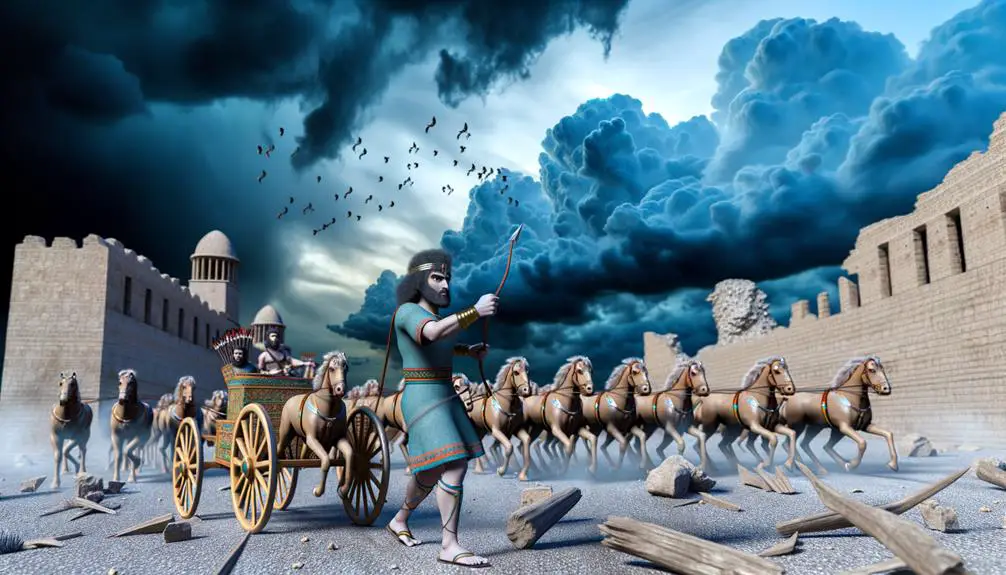
Delving into the military campaigns of Tiglath Pileser III, you'll uncover a series of aggressive expansions that reshaped the political landscape of the ancient Near East. His reign marked a turning point in Assyrian military strategy, characterized by the innovative use of siege tactics and diplomatic strategies to subdue his adversaries.
You'll find that Tiglath Pileser III's approach to warfare was multifaceted. He didn't solely rely on brute force; he was also a master of psychological warfare and diplomacy. His siege tactics were revolutionary for the time, involving not just the surrounding and starving of cities but also the use of engineering skills to breach city walls. This included the construction of ramps and the deployment of battering rams, which allowed his forces to penetrate defenses that were previously thought impenetrable.
Moreover, Tiglath Pileser III's diplomatic strategies were equally impactful. He adeptly formed alliances and manipulated rival states against each other, ensuring that his enemies were often divided and weakened before he even deployed his troops. This strategic foresight enabled him to expand Assyrian control over vast territories without engaging in prolonged conflicts.
What's particularly noteworthy is how he integrated the conquered peoples into the Assyrian empire. Through a policy of deportation and resettlement, he diluted potential rebellions and ensured the loyalty of newly acquired territories. This approach not only secured his military conquests but also facilitated the assimilation of diverse cultures into the Assyrian empire, strengthening its socio-political fabric.
Influence on Israel and Judah
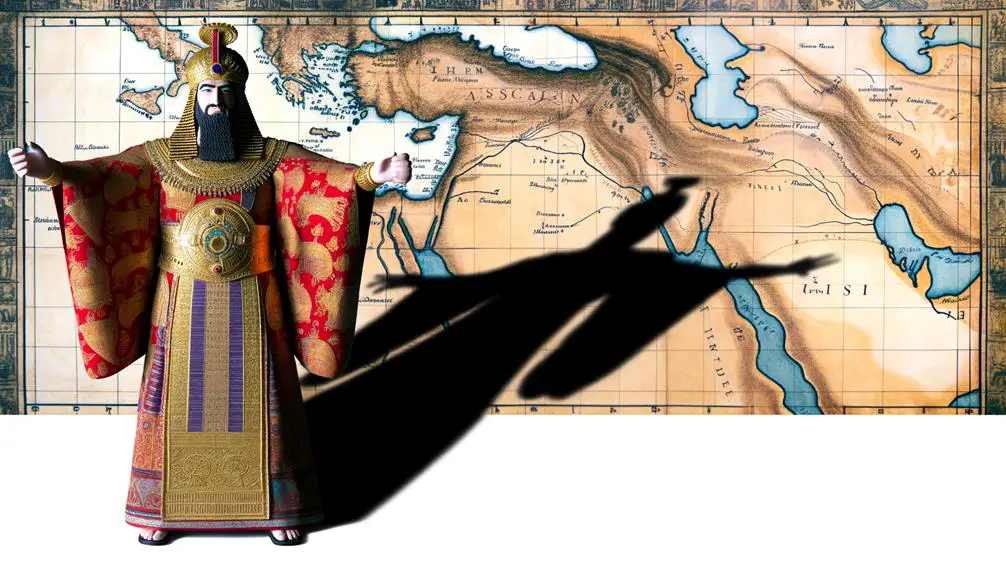
Several of Tiglath Pileser III's military campaigns profoundly affected the kingdoms of Israel and Judah, reshaping their political landscapes and altering their fates significantly. His conquests and policies towards these kingdoms had a lasting influence, particularly in terms of economic impact and diplomatic relations.
- Economic Impact: Tiglath Pileser III's campaigns led to significant tributes imposed on conquered territories, including Israel and Judah. This economic burden affected the internal stability and prosperity of these kingdoms. The heavy tributes drained their treasuries, leading to increased taxation among their populations and exacerbating social disparities.
- Diplomatic Relations: His reign marked a shift in the geopolitical dynamics of the region. Israel and Judah found themselves navigating a complex web of alliances and enmities, often influenced by Assyrian diplomatic pressures. The Assyrian king's expansionist policies forced these kingdoms to reconsider their foreign policies, sometimes leading to internal divisions and external conflicts.
- Military Strategy and Fortifications: The threat of Tiglath Pileser III's military might prompted Israel and Judah to fortify their cities and revise their military strategies. This preparation for potential Assyrian aggression had lasting effects on their military architectures and defensive capabilities.
Through these campaigns, Tiglath Pileser III didn't just expand his empire's borders; he fundamentally transformed the political and economic landscapes of Israel and Judah. These changes had a domino effect, influencing their subsequent history and interactions with other regional powers. His reign, therefore, stands as a pivotal period in the biblical narrative, showcasing the intertwined fate of Assyria with these ancient kingdoms.
Theological Implications

Tiglath Pileser III's military campaigns and political maneuvers hold deep theological implications for the kingdoms of Israel and Judah, reshaping their religious landscapes and beliefs. These events aren't just historical footnotes; they're pivotal moments that challenge and redefine the understanding of divine justice and the role of prophetic warnings in these societies.
You'll find that the incursions and subsequent tributary statuses imposed by Tiglath Pileser III prompt a profound theological reflection among the Israelites and Judeans. They're forced to grapple with the concept of divine justice. Is this suffering a punishment from their God, a test, or merely the result of geopolitical dynamics beyond their control? This question isn't just academic; it cuts to the heart of their relationship with their deity and each other.
Moreover, the role of prophets during this tumultuous period gains an unprecedented prominence. Prophetic warnings, previously perhaps seen as admonitions, now take on a new urgency. These prophets don't just forecast doom; they're interpreters of the present, analysts who link current events to spiritual failings and call for repentance. Their words are a bridge between the divine and the earthly, offering a theological lens through which to view Tiglath Pileser's conquests.
This era, marked by Tiglath Pileser's dominance, thus serves as a crucible for theological evolution in Israel and Judah. It pushes these kingdoms to reconsider their notions of divine justice, the significance of prophetic warnings, and ultimately, their understanding of their place in a world governed by the whims of both gods and kings.
Frequently Asked Questions
How Do Modern Historians Reconcile Discrepancies Between the Biblical Account of Tiglath Pileser and Assyrian Historical Records?
You'll find that modern historians use textual criticism and chronological analysis to bridge gaps between Assyrian records and other historical accounts. By critically examining texts and timelines, they identify overlaps and discrepancies, offering insights into how events might've unfolded.
This analytical approach helps reconcile differences, providing a more nuanced understanding of historical narratives. It's a detailed, objective method that sheds light on the complexities of ancient history.
What Archaeological Evidence Exists Today That Supports the Existence and Reign of Tiglath Pileser as Described in the Bible?
You'll find that excavation sites and inscription analysis have significantly contributed to understanding Tiglath Pileser's reign. Archaeologists have unearthed artifacts and inscriptions that corroborate historical records of his existence. These findings, from various locations, provide tangible proof of his rule and actions.
Through detailed analysis of these inscriptions, historians can better align the archaeological evidence with the narratives, bridging gaps and resolving discrepancies in the historical account of his reign.
How Did Tiglath Pileser's Reign Influence the Cultural and Religious Practices of Neighboring Nations Not Directly Mentioned in the Bible?
Tiglath Pileser's reign markedly influenced the cultural and religious practices of neighboring nations through trade influences and diplomatic marriages.
By expanding trade routes, you'd find a blending of religious symbols and practices as goods moved across borders.
Additionally, diplomatic marriages between his empire and other states facilitated not just political alliances but also cultural and religious exchanges.
These marriages, in turn, subtly shifted local traditions, blending different beliefs and practices.
What Role Did Tiglath Pileser Play in the Development of the Assyrian Empire's Administrative and Governance Systems?
You're diving into a world where Tiglath Pileser was a game-changer, way ahead of his time. His reign marked a turning point in the Assyrian Empire through relentless military campaigns that expanded its borders.
Beyond the battlefield, he was a mastermind of administrative reforms, overhauling governance systems to streamline control and improve efficiency. These changes weren't just about power; they were strategic moves that solidified Assyria's dominance and legacy in ancient history.
How Has Tiglath Pileser Been Depicted in Literature, Art, and Popular Culture Throughout History, and How Do These Portrayals Compare to the Biblical and Historical Accounts?
Throughout history, you'll find that Tiglath Pileser's depictions in literature, art, and popular culture vary widely. These portrayals, ranging from artistic interpretations to nuanced narratives, often reflect the era's portrayal ethics.
When compared to historical accounts, you might notice discrepancies or embellishments. It's crucial to analyze these representations critically, understanding that each artist's or author's perspective shapes how Tiglath Pileser's legacy is interpreted and remembered.
Conclusion
As you've seen, Tiglath-Pileser's reign wasn't just a footnote in history; it was a pivotal moment that reshaped the biblical narrative. His military campaigns coincidentally aligned with significant theological shifts within Israel and Judah, highlighting the interconnectedness of politics, war, and faith.
Analyzing his influence reveals a detailed picture of ancient geopolitics and its profound impact on religious development. This exploration underscores the undeniable fact that historical figures like Tiglath-Pileser leave indelible marks on both their contemporaries and the theological landscapes they inadvertently sculpt.



Sign up